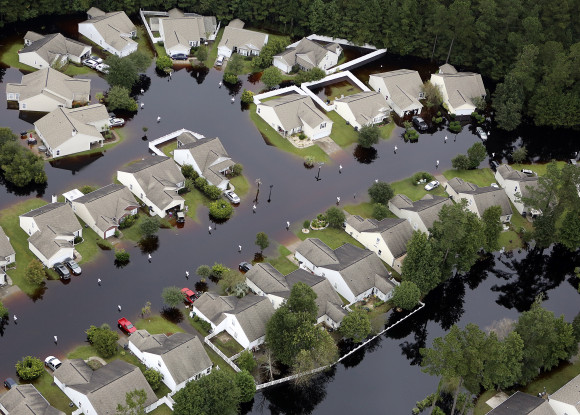The potential exposure home insurers in South Carolina face from the early October storm that flooded the state is estimated to be over $18 billion, according to catastrophe modeling firm CoreLogic.
Richland County had the most exposure with 8,185 damaged homes and $1.3 billion in damage on the high-risk side and 13,027 homes and $1.78 billion in damage to moderate-risks structures. Lexington County was next with 7,453 structures damaged and $852 million in high-risk impact and 10,691 structures and $1.22 billion in moderate-risk impact. The risk levels are defined by the CoreLogic Flood Risk Score, which incorporates a variety of data elements that inform the risk at the property level.
The exposure value data to the more than 159,000 homes in the 22 counties declared a federal disaster by Federal Emergency Management Agency (FEMA) represent tax assessment values for the structure only, CoreLogic reported. CoreLogic’s information was derived from its proprietary Flood Risk Score and Flash Flood Risk Score databases.
The information on the insured value of losses from the storm, which hit the state Oct. 1 through Oct. 5 bringing over 2 feet of rain to some locations, was still not available from the South Carolina Department of Insurance (SCDOI) as of press time on Oct. 27. However, numbers are trickling in as SCDOI Director Raymond Farmer issued a catastrophe claims data call to all authorized property and casualty insurance companies on Oct. 12 with a deadline of Oct. 19 for claims that had come in by Oct. 14, 2015.
A preliminary report from the U.S. Geological Survey cited a Los Angeles Times story that said agriculture losses from flooding were estimated to be at least $300 million and total damages to exceed $1 billion.
Flood Report
The USGS “South Carolina Flood of October 2015” report said the heavy rainfall that fell in South Carolina at the beginning of October came from an upper atmospheric low-pressure system that funneled tropical moisture from Hurricane Joaquin.
USGS measured streamflows at 86 locations around the state during the storm and recorded peaks of record at 17 locations with 15 other locations ranking in the top 5 for the period of record. Almost 27 inches of rain fell near Mount Pleasant in Charleston County during this period, the highest amount recorded from the storm.
The storm led to moderate and major river flooding at selected National Weather Service river forecast points across South Carolina, with at least 20 NWS river forecast locations exceeding established flood stages. At least 17 minor dam failures occurred and strong east/northeasterly winds led to downed trees and power lines statewide.
Recovery Efforts Continue
As the rain subsided and the flood waters began to finally recede by mid-October, recovery mode was in effect and will continue for some time.
The Associated Press reported that South Carolina Gov. Nikki Haley had extended the State of Emergency until Oct. 30 so the National Guard could continue assisting with clean-up efforts.
Disaster loans were available to 40 counties in South Carolina as of Oct. 21, according to the Small Business Administration. The number of counties eligible for individual FEMA assistance was at 22 as of Oct. 25. They include: Bamberg, Berkeley, Calhoun, Charleston, Clarendon, Colleton, Darlington, Dorchester, Fairfield, Florence, Georgetown, Greenwood, Horry, Kershaw, Lee, Lexington, Marion, Newberry, Orangeburg, Richland, Sumter and Williamsburg Counties.
Individual assistance can include grants for temporary housing and home repairs, low-cost loans to cover uninsured property losses and other programs to help individuals and business owners. More than 17,000 applications and more than $50 million in aid had been approved by Oct. 27.
“I’ve been through disasters,” said U.S. SBA Head Maria Contreras-Sweet when she visited the state, as reported by The Greenvitlle News. “I know what it’s like to be desperate, to try and preserve your business. This is not the time to have too much pride. This is the time to pick up the phone and call those who are ready and want to help you.”
The news outlet quoted SBA as having received 1,600 loan applications in the state; 110 were approved totaling $2.5 million in aid, as of Oct. 21.
Despite no official damage estimates, AP said the floods will likely be the costliest disaster since Hurricane Hugo in 1989, which did $13.5 billion of damage to the U.S. in inflation-adjusted dollars, most of it in South Carolina. Haley told AP she can’t know how it will be paid for until the damage estimate is in.
“We’re going to do the assessments. We’re going to see what FEMA takes care of. We’re going to see what the state needs to do after that. I’m not touching any of the reserve (funds) because we don’t have to at this point and time. If that changes, we will deal with that,” Haley said.
*Clarification: This story has been updated from its original version to state: “A preliminary report from the U.S. Geological Survey cited a Los Angeles Times story that said agriculture losses from flooding were estimated to be at least $300 million and total damages to exceed $1 billion.”
Topics USA Flood Windstorm Agribusiness South Carolina
Was this article valuable?
Here are more articles you may enjoy.



 Is the AI Boom a Bubble Waiting to Pop? Here’s What History Says
Is the AI Boom a Bubble Waiting to Pop? Here’s What History Says  Law Firm Faces Sanctions for Failing to Vet Ugandan Claims in $6B 3M Case
Law Firm Faces Sanctions for Failing to Vet Ugandan Claims in $6B 3M Case  Howden US Tells Judge Brown & Brown Employees Fled Due to ‘Mistreatment’
Howden US Tells Judge Brown & Brown Employees Fled Due to ‘Mistreatment’  New York Regulates Consumer Litigation Financing
New York Regulates Consumer Litigation Financing 


